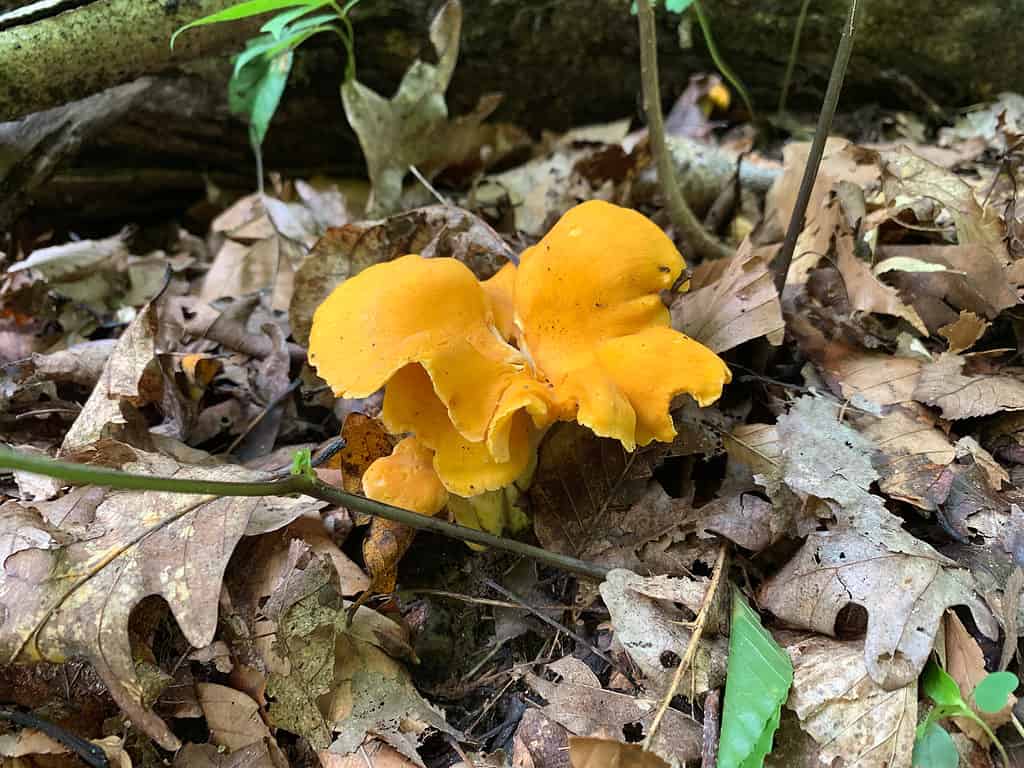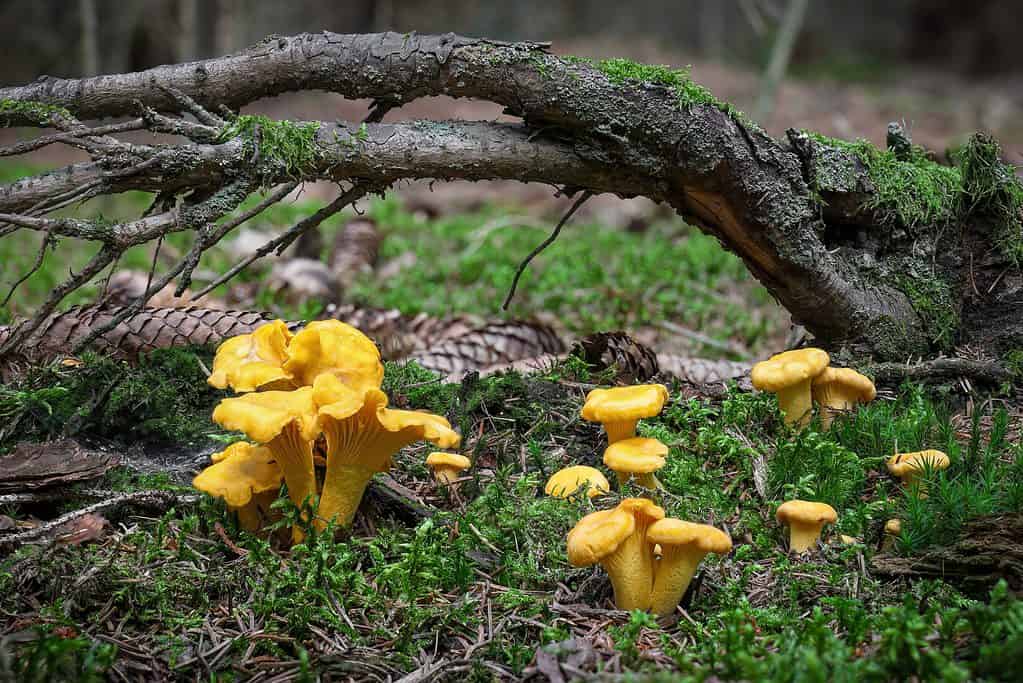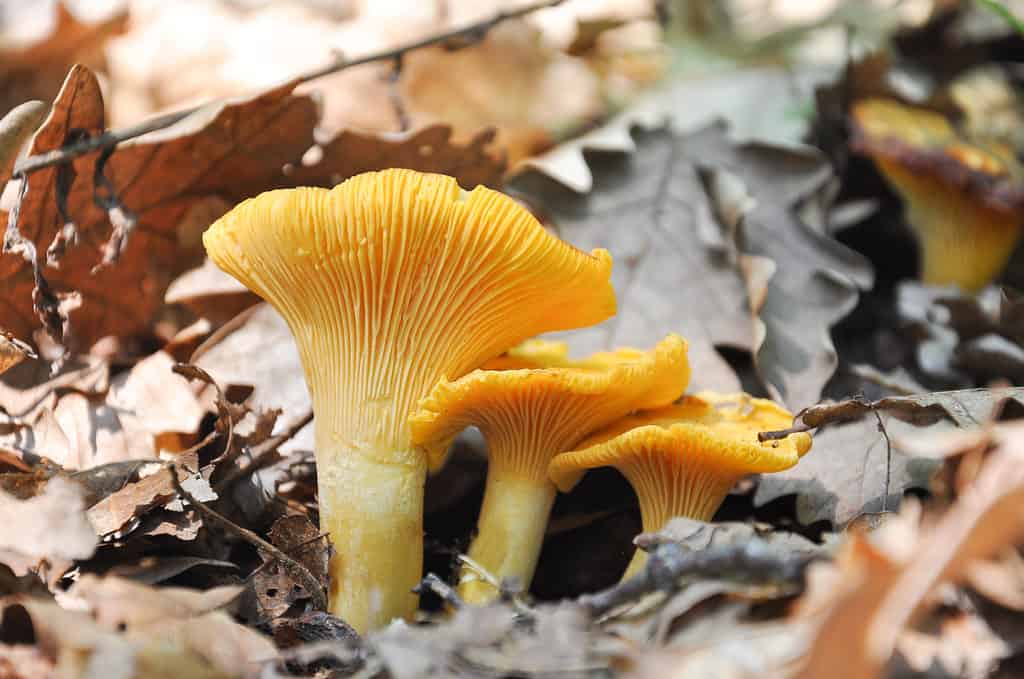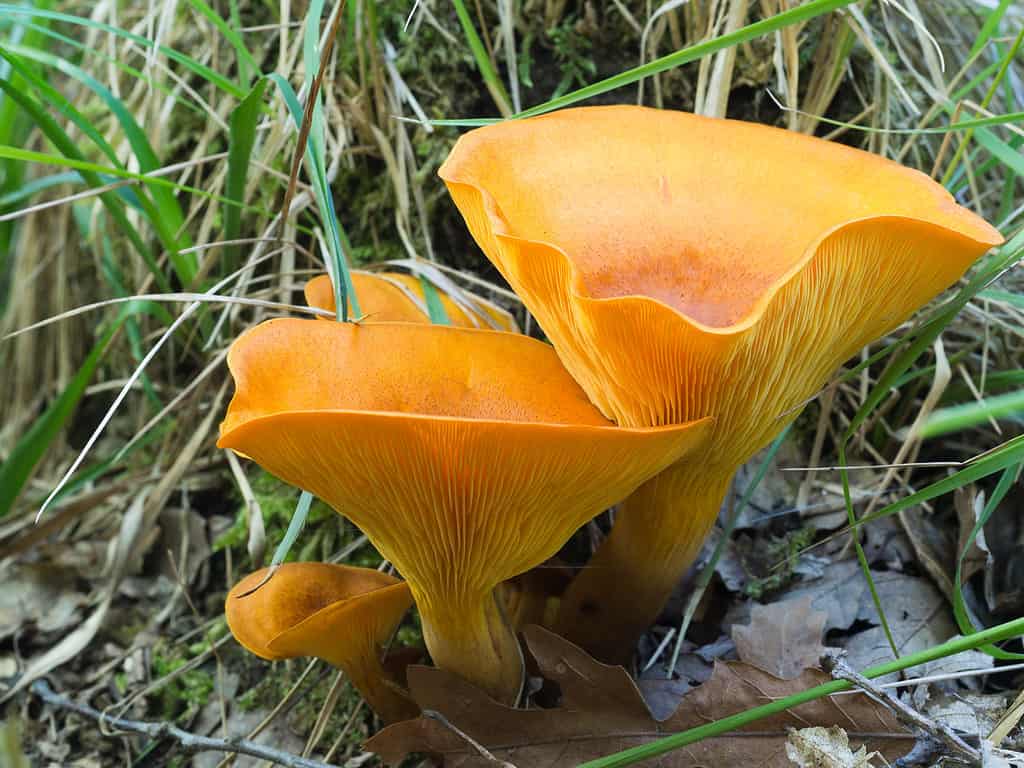If you enjoy French cooking or eating seasonal foods, you may have seen recipes that reference mushrooms called “chanterelles” or “girolles.” At times, these words seem to be used interchangeably. Perhaps this has prompted you to wonder, “Are these two mushrooms the same? Are they different?”
In fact, when you see people referring to chanterelles, they can be speaking about multiple different mushroom species. Most of the fungi called chanterelles are edible species in the Cantharellus genus. Chanterelles grow in multiple regions of the world, but are very popular in Europe and are one of the major types of mushrooms that people forage in North America, where they thrive in moist, coniferous forest environments. These mushroom species are valued in the culinary world and have a unique flavor suitable for use in sautés, wine pasta sauces, and many other delicious recipes.
When you hear chefs or grocers refer to chanterelle mushrooms by another name, you may hear them called girolles. Particularly if you follow French cuisine or shop at a French grocery, you may see a reference to girolles. At other times, recipes may also seem to use the name chanterelle and girolle interchangeably to refer to the same mushroom ingredient. Are chanterelles and girolles two different mushrooms? Are they identical? How do you know which word to use? Or more importantly, how do you know if you are using the right mushroom? This article will explore all of these questions, so that you know the differences between chanterelles and girolles. Let’s start learning about these mushrooms together now!
Chanterelles vs. Girolles
Descriptions of Chanterelles vs. Girolles
Chanterelles
Chanterelles are fungi in the Cantharellus genus of the Cantharellaceae family. Of the many species in the genus, some of the most well-known are the golden chanterelles of Europe and North America. Cantharellus cibarius grows in Europe, while North America has several common species, including Cantharellus appalachiensis, Cantharellus elensis, Cantharellus fosomus, Cantharellus lateritius, and Cantharellus phasmatis. In North America, there are more than 40 different species of chanterelles, which grow natively and can typically be found near pine or oak trees, especially in deciduous forest soil. If you look in these wooded areas, you may find chanterelles growing individually or in groups, located at the base of pine, oak, or other trees.
In both Europe and North America, chanterelles are commonly-foraged edible wild mushrooms. For many years, researchers believed that the majority of chanterelles in North America were variations of the Cantharellus cibarius species. However, further research has caused mycologists (researchers who study fungi) to now believe that Cantharellus cibarius is not native to North America at all. Rather, the chanterelles in North America actually represent a number of different, distinct species. Collectively, these species are called chanterelles, though there are variations in growing needs, appearance, and taste across different species.

©CampSmoke/Shutterstock.com
Girolles
While people in North America and many parts of Europe do use girolles synonymously with chanterelles, chanterelle is a broad category that includes the many species in the Cantharellus genus. As described above, a chanterelle in Europe is typically the species found growing across the continent: Cantharellus cibarius. However, in North America, this word can apply to many different species in the same genus, and other species grow in different parts of the world.
In contrast, girolles is a narrow term that refers to only one species. Because it is people in France who use this term, you will find that it is primarily chefs cooking French cuisine who reference girolles. In this European context, it is only the Cantharellus cibarius species that can be called a girolle, because that is the species growing in the region. which appears in recipes. This is the species found in Europe and which does not grow in North America, so it is the one that the French forage and are familiar with.
This species, Cantharellus cibarius, can be described using more precise language than when simply summarizing shared features across all chanterelles. Girolles spread in a funnel shape and have no true gills, only false gills that are smooth ridges. Cantharellus cibarius are medium to large in size. They grow out of moist forest soil to reach 1 to 4 inches across, though some are 6 inches or bigger. They reach heights of 2 to 4 inches tall, with the width tapering toward the base, into a smaller stem.

©muuraa/Shutterstock.com
Key Differences
In summary, the terms chanterelle and girolle are often used interchangeably. However, chanterelle is most often used in reference to many different species in the Cantharellus genus, including Cantharellus cibarius along with many others. In contrast, girolle is a term that is most often used to refer to Cantharellus cibarius exclusively, particularly in France and among French chefs. When you see a recipe or cook mention a girolle, they are likely referring to this species. With that in mind, let’s learn more about the group of mushrooms called chanterelles, including the species Cantharellus cibarius, now.
Chanterelles vs. Girolles: History
Chanterelles grow across the world, but there is an especially long and rich culinary tradition of using them in Europe. In both Europe and North America, people have long foraged for chanterelle mushrooms in the wild, where they grow in forests and grow in symbiosis with various tree species, especially pine and oak trees. Because they are not easily cultivated, chanterelles are not as widely-available as other popular mushroom species. However, they are a favorite among foragers and inhabit a high position in the cuisines of many European cultures from the Mediterranean to Scandinavia.
For many years, it was believed that the chanterelles in North America were Cantharellus cibarius, the golden chanterelle, which grows widely across Europe. Researchers now know that Cantharellus cibarius is not present in North America. However, North America is home to a great diversity of species in the Cantharellus genus. Many of these are edible, and several have a similar shape and color as that of the European golden chanterelle. These can be white, orange, or yellow in color. They typically grow near hardwood trees, but can be found near a diversity of tree species, such as beech, birch, maple, and oak, as well as pine or hemlock conifers.
Cantharellus cibarius, the species in the Cantharellus genus that most chefs and French writers refer to as a girolle, grows exclusively in Europe.

©Jaroslav Machacek/Shutterstock.com
Chanterelles vs. Girolles: Appearance
Many chanterelles are small or medium in size with wavy, funnel-shaped caps and thick stems. Their gill-like ridges are not gills, but actually part of the mushroom cap itself. Some of the most common species of chanterelles are golden chanterelles, a group which includes Cantharellus cibarius. These are known for their orange or yellow color. Chanterelles grow individually or in small groups typically in the soil at the base of a tree, often in forests populated with oak or other hardwood trees. Chanterelle species vary in size and shape. However, much of the time, when people are referring to chanterelles, they have Cantharellus cibarius or similar species in mind.
Cantharellus cibarius, which is often called a girolle, grows individually or in a group in mossy or grassy areas. This species often grows near birch and oak trees, where they enjoy a symbiotic relationship with the tree roots. They are orange or bright yellow in color and grow with wrinkles or ridges, which are the same color and texture as the rest of the mushroom cap. Their wavy caps easily reach 4 inches tall and 4 inches wide, but sometimes bigger.

©Ivan Marjanovic/Shutterstock.com
Chanterelles vs. Girolles: Growing Conditions
Chanterelles have a range of needs, depending on the species and region of the world where they are located. While some chanterelle species grow near pine or hemlock trees, others grow near beech or oak. You may see them appear in the moist soil near the base of these trees sometime during the summer, and grow over the course of autumn and into winter. During this time, they have a mutually-beneficial relationship with the trees they grow near. As a mycorrhizal species, the mycelium of the fungus attaches to the roots of the trees, allowing the roots to absorb more nutrients and water. In return, the chanterelles gain nutrients from the living tree.
This symbiotic relationship makes large-scale commercial production difficult to achieve, however. As a result, chanterelles are primarily foraged and not cultivated, though researchers are actively exploring new ways to begin cultivating chanterelle mushrooms.
Cantharellus cibarius grows throughout Eastern Europe from May to October, and in Western Europe from June or July to December, or even into January depending on the climate. You can find these girolles growing in countries such as Austria, England, France, Germany, Scotland, and many others, as the species is widespread.

©Kadamedo/Shutterstock.com
Chanterelles vs. Girolles: Uses and Taste
Chanterelles are harvested from the wild, primarily for culinary purposes. To preserve their flavor and delicacy, cooks may recommend buying chanterelles fresh and cooking them simply and gently to keep their original texture and fruity flavor.
Many European cultures have long culinary histories for using chanterelles. With a texture that is described as meaty and flavor often called apricot- or peach-like and peppery, the girolle brings a light and delicate flavor and pleasant texture. With that in mind, many recipes seek to enhance the natural flavor and texture, instead of reducing or limiting it. Girolles are often used in pasta dishes, in soup, cooked lightly in butter, added to meat dishes, or eaten by themselves. Because the mushrooms have good protein content and offer other nutritional benefits, they are sometimes also added to dishes as a healthy protein and alternative to meat.
Chanterelles vs. Girolles: Health Benefits
Chanterelle mushrooms, including Cantharellus cibarius, are a good source of many different vitamins and minerals. In particular, chanterelles are a good source of vitamin A, E, C, and D. However, they are particularly well-known for being rich in vitamin D, which they develop from growing in a sunny outdoor environment. Eating half a cup of chanterelles can provide you with between 30 and 100 percent of your daily recommended intake. They are also rich in beta-carotene, lycopene, fiber, and copper. Some health experts suggest eating chanterelle mushrooms as an excellent source of polysaccharides like chitin and chitosan. These compounds stimulate the immune system to produce more cells, reduce inflammation, and lower the risk of cancer.
There is research showing that eating Cantharellus cibarius specifically has multiple health benefits. Its biological properties include being antimicrobial, anti-inflammatory, and wound-healing, among others.
Chanterelles vs. Girolles: Cautions
If you choose to forage mushrooms in the woods, be careful not to mistakenly harvest a toxic chanterelle lookalike. In general, there are many poisonous mushroom species that can provoke a range of symptoms. One of the species which can be confused with girolles is the jack-o-lantern mushroom, Omphalotus olearius. Though both have an orange or yellow color, jack-o-lanterns are toxic and can cause symptoms such as vomiting, cramps, and diarrhea. You can pay attention to a few key differences that set apart girolles from the jack-o-lantern. For example, the jack-o-lantern has sharp gills. These look quite different compared to the false, forked gills and ridges of a girolle. You can also do a different test: the bioluminescence test!
Jack-o-lanterns are bioluminescent. They glow in the dark! If you can find a dark place, see if your mushroom seems to glow. If it does, it may be a jack-o-lantern – and while it’s safe for you to touch, you should not eat it.
Other good steps to take include cooking your mushrooms, instead of eating them raw, and eating only a small piece before consuming a larger quantity. Monitor yourself for symptoms such as nausea, dizziness, or vomiting.

©Sarah2/Shutterstock.com
In Summary
This article seeks to clarify a common point of confusion: are chanterelles and girolles different or the same? What are the differences between them? As this article describes, chanterelles are a large category which includes numerous different species of mushrooms called chanterelles. In comparison, the term girolles usually refers to one specific species of edible fungi. If you find yourself in Europe, try searching in the woods for that native species, Cantharellus cibarius. From there, you can try a classic recipe from a country like France or Germany to cook your girolles and enjoy this fruity, meaty mushroom! If not, try researching which chanterelles might grow near you – but be cautious and consult experts if you are not yet a confident mushroom forager.
Next Up
- Shiitake Mushrooms: A Complete Guide
- Chanterelle Mushrooms: A Complete Guide
- Chicken of the Woods Mushrooms: A Complete Guide
The post Chanterelles vs. Girolles appeared first on AZ Animals.
from Animal News, Facts, Rankings, and More! - AZ Animals https://ift.tt/rlhUgbV